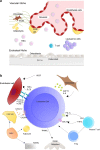Acute Myeloid Leukaemia in Its Niche: the Bone Marrow Microenvironment in Acute Myeloid Leukaemia
- PMID: 32048054
- PMCID: PMC7012995
- DOI: 10.1007/s11912-020-0885-0
Acute Myeloid Leukaemia in Its Niche: the Bone Marrow Microenvironment in Acute Myeloid Leukaemia
Abstract
Purpose of review: Acute myeloid leukaemia (AML) is a heterogeneous malignancy for which treatment options remain suboptimal. It is clear that a greater understanding of the biology of the AML niche will enable new therapeutic strategies to be developed in order to improve treatment outcomes for patients.
Recent findings: Recent evidence has highlighted the importance of the bone marrow microenvironment in protecting leukaemia cells, and in particular leukaemic stem cells from chemotherapy-induced cell death. This includes mesenchymal stem cells supporting growth and preventing apoptosis, and altered action and secretion profiles of other niche components including adipocytes, endothelial cells and T cells. Here, we provide a detailed overview of the current understanding of the AML bone marrow microenvironment. Clinical trials of agents that mobilise leukaemic stem cells from the bone marrow are currently ongoing and show early promise. Future challenges will involve combining these novel therapies targeted at the AML niche with conventional chemotherapy treatment.
Keywords: AML; Acute myeloid leukaemia; Blast; Bone marrow; CXCL12; CXCR4; DNMT3A; Leukaemic stem cell; Mesenchymal cells; Microenvironment; Niche; Stroma; Stromal cells; T cells.
Conflict of interest statement
Eleni Ladikou, Helena Sivaloganathan, Andrea Pepper and Timothy Chevassut declare they have no conflict of interest.
Figures
Similar articles
-
Bone Marrow Microenvironment as a Source of New Drug Targets for the Treatment of Acute Myeloid Leukaemia.Int J Mol Sci. 2022 Dec 29;24(1):563. doi: 10.3390/ijms24010563. Int J Mol Sci. 2022. PMID: 36614005 Free PMC article. Review.
-
The bone marrow microenvironment - Home of the leukemic blasts.Blood Rev. 2017 Sep;31(5):277-286. doi: 10.1016/j.blre.2017.03.004. Epub 2017 Mar 12. Blood Rev. 2017. PMID: 28318761 Review.
-
Endothelial cells: major players in acute myeloid leukaemia.Blood Rev. 2022 Jul;54:100932. doi: 10.1016/j.blre.2022.100932. Epub 2022 Feb 2. Blood Rev. 2022. PMID: 35148910 Review.
-
[CXCR4: a new therapeutic target of the leukaemic cell? Role of the SDF-1/CXCR4 axis in acute myeloid leukaemia].Bull Cancer. 2014 Jun;101(6):593-604. doi: 10.1684/bdc.2014.1925. Bull Cancer. 2014. PMID: 24977448 Review. French.
-
Stromal bone marrow fibroblasts and mesenchymal stem cells support acute myeloid leukaemia cells and promote therapy resistance.Br J Pharmacol. 2024 Jan;181(2):216-237. doi: 10.1111/bph.16028. Epub 2023 Jan 29. Br J Pharmacol. 2024. PMID: 36609915 Review.
Cited by
-
Prognostic and therapeutic implications of iron-related cell death pathways in acute myeloid leukemia.Front Oncol. 2023 Sep 5;13:1222098. doi: 10.3389/fonc.2023.1222098. eCollection 2023. Front Oncol. 2023. PMID: 37736548 Free PMC article.
-
Involvement of GPx-3 in the Reciprocal Control of Redox Metabolism in the Leukemic Niche.Int J Mol Sci. 2020 Nov 14;21(22):8584. doi: 10.3390/ijms21228584. Int J Mol Sci. 2020. PMID: 33202543 Free PMC article.
-
In Vitro and In Vivo Modeling of Normal and Leukemic Bone Marrow Niches: Cellular Senescence Contribution to Leukemia Induction and Progression.Int J Mol Sci. 2022 Jul 1;23(13):7350. doi: 10.3390/ijms23137350. Int J Mol Sci. 2022. PMID: 35806354 Free PMC article. Review.
-
Primary mesenchymal stromal cells in co-culture with leukaemic HL-60 cells are sensitised to cytarabine-induced genotoxicity, while leukaemic cells are protected.Mutagenesis. 2021 Nov 29;36(6):419-428. doi: 10.1093/mutage/geab033. Mutagenesis. 2021. PMID: 34505878 Free PMC article.
-
Modelling post-chemotherapy stem cell dynamics in the bone marrow niche of AML patients.Sci Rep. 2024 Oct 23;14(1):25060. doi: 10.1038/s41598-024-75429-7. Sci Rep. 2024. PMID: 39443599 Free PMC article.
References
-
- Hann IM, Stevens RF, Goldstone AH, Rees JK, Wheatley K, Gray RG, Burnett AK. Randomized comparison of DAT versus ADE as induction chemotherapy in children and younger adults with acute myeloid leukemia. Results of the Medical Research Council's 10th AML trial (MRC AML10). Adult and childhood Leukaemia working parties of the Medical Research Council. Blood. 1997;89(7):2311–2318. - PubMed
-
- Liersch R, Muller-Tidow C, Berdel WE, Krug U. Prognostic factors for acute myeloid leukaemia in adults--biological significance and clinical use. Br J Haematol. 2014;165(1):17–38. - PubMed
-
- Schofield R. The relationship between the spleen colony-forming cell and the haemopoietic stem cell. Blood Cells. 1978;4(1–2):7–25. - PubMed
Publication types
MeSH terms
LinkOut - more resources
Full Text Sources
Other Literature Sources
Medical
Research Materials


